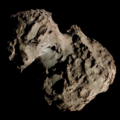C/1974 C1 (Bradfield)
Appearance
(Redirected from C/1974 C1)
 | |
| Discovery[2] | |
|---|---|
| Discovered by | William A. Bradfield |
| Discovery site | Dernancourt, Australia |
| Discovery date | 12 February 1974 |
| Designations | |
| 1974 III, 1974b[3] | |
| Orbital characteristics[4][5] | |
| Epoch | 20 April 1974 (JD 2442157.5) |
| Observation arc | 277 days |
| Number of observations | 173 |
| Aphelion | ~2,890 AU (inbound) ~2,830 AU (outbound) |
| Perihelion | 0.503 AU |
| Semi-major axis | ~1,890 AU |
| Eccentricity | 0.99973 |
| Orbital period | ~54,800 years (inbound) ~53,300 years (outbound) |
| Inclination | 61.285° |
| 143.73° | |
| Argument of periapsis | 333.13° |
| Mean anomaly | 0.0004° |
| Last perihelion | 18 March 1974 |
| TJupiter | 0.425 |
| Earth MOID | 0.444 AU |
| Jupiter MOID | 0.667 AU |
| Physical characteristics[7][8] | |
Mean diameter | 5–10 km (3.1–6.2 mi) |
| 0.70 | |
| Comet total magnitude (M1) | 8.6 |
| 3.9 (1974 apparition)[6] | |
C/1974 C1 (Bradfield) is a non-periodic comet that became visible to the naked eye in 1974. It is the second of 18 comets discovered by William A. Bradfield.
References
[edit]- ^ A. I. Ershkovich; M. B. Niedner Jr.; J. C. Brandt (1982). "On the flaring of cometary plasma tails". Astrophysical Journal. 262: 396–406. Bibcode:1982ApJ...262..396E. doi:10.1086/160433.
- ^ W. A. Bradfield; G. Thompson; D. Gans; M. P. Candy (15 February 1974). B. G. Marsden (ed.). "Comet Bradfield (1974b)". IAU Circular. 2633 (1). Bibcode:1974IAUC.2633....1B.
- ^ "Comet Names and Designations". International Comet Quarterly. Retrieved 9 June 2025.
- ^ "Barycentric Osculating Orbital Elements for Comet C/1974 C1 (Bradfield) in epoch 1800 and 2200". JPL Horizons On-Line Ephemeris System. Jet Propulsion Laboratory. Retrieved 8 June 2025. (Solution using the Solar System's barycenter (Sun+Jupiter). Select Ephemeris Type:Elements and Center:@0)
- ^ "C/1974 C1 (Bradfield) – JPL Small-Body Database Lookup". ssd.jpl.nasa.gov. Jet Propulsion Laboratory. Retrieved 3 January 2024.
- ^ "Brightest comets seen since 1935". International Comet Quarterly. Retrieved 12 June 2025.
- ^ E. P. Ney (1974). "Multiband photometry of Comets Kohoutek, Bennett, Bradfield, and Encke". Icarus. 23 (4): 551–560. doi:10.1016/0019-1035(74)90018-9.
- ^ F. M. Strauss (1979). "A technique for brightness measurements of cometary nuclei". Icarus. 39 (1): 65–68. doi:10.1016/0019-1035(79)90100-3.
External links
[edit]- C/1974 C1 at the JPL Small-Body Database


